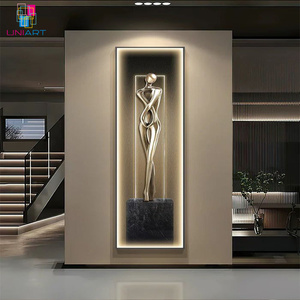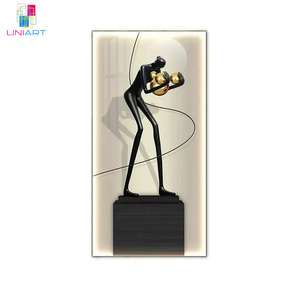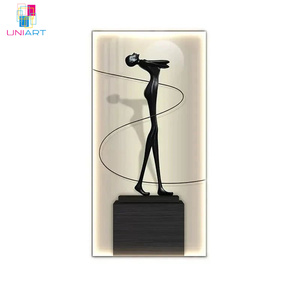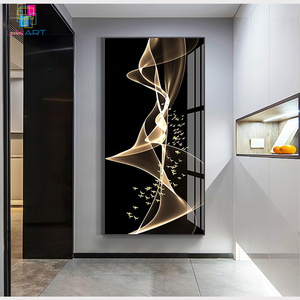(143041 products available)


























































































































































































































3D design art is a creative field that involves designing and creating three-dimensional visual representations of objects, characters, environments, and more. It can be used in various industries, including gaming, animation, architecture, product design, and virtual reality. Here are some key aspects and types of 3D design art:
3D Models:
3D modeling is the foundation of 3D design art. A 3D model is a digital representation of an object or character created using specialized software. These models can range from simple geometric shapes to highly detailed and realistic representations. There are different modeling techniques, including polygonal modeling (shaping objects with polygons), sculpting (digitally sculpting like clay), and procedural (using algorithms to create things).
Texturing and Materials:
Texturing adds surface details to 3D models, making them look more realistic or stylized. It involves creating and applying textures, which are 2D images that represent the surface properties of an object, like color, roughness, and patterns. Materials define how light interacts with a model, affecting its appearance in the virtual world.
Lighting and Rendering:
Lighting is crucial in creating the right atmosphere and mood in 3D scenes. It involves placing virtual lights, such as spotlights, point lights, and ambient lights, to illuminate the scene. Rendering is the process of generating the final 2D image or animation from a 3D scene. It calculates how objects, textures, materials, lighting, and cameras work together to produce a visual output. Real-time rendering (used in games and simulations) and pre-rendering (used in movies and static images) are two common rendering types.
Animation:
3D animation brings static models to life by creating the illusion of movement. Animation can be done through keyframing (setting important frames and interpolating between them), rigging (creating a digital skeleton for character animation), and physics simulations (realistically simulating object interactions based on physical laws).
3D Animation:
3D animation is creating moving images and visual effects in a three-dimensional space. It involves making 3D models and bringing them to life through motion. 3D animation can be used for movies, games, simulations, and more. It allows for realistic and imaginative storytelling.
3D Visualization:
3D visualization is making complex data and concepts easier to understand using 3D graphics. It can show things like buildings, products, or scientific results. 3D visualization helps people see and learn faster. It makes information clearer and more engaging. It is also called data visualization.
3D glass printing opens up a world of design possibilities, enabling the creation of intricate and customized glass objects. By leveraging the unique properties of glass as a material, designers can make functional items or purely artistic pieces with a three-dimensional visual impact.
Design freedom
3D glass printing provides designers with unlimited creative opportunities. They are no longer restricted to the limitations of traditional glass manufacturing processes. Complex geometries, interlocking parts, and delicate structures with fine details can be designed and printed in glass. This technology allows for the creation of personalized glass objects, such as jewelry or awards, and large-scale architectural installations. The intricate patterns and translucent qualities of glass can be exploited to make unique functional or purely artistic pieces.
Material properties
Glass has unique characteristics that can be used in design. For example, the light transmission, refraction, and reflection properties of glass create stunning visual effects. The choice of glass material also affects the printed object's appearance and performance. Different types of glass can be used, such as clear, frosted, or colored glass, depending on the desired effect. The material properties of glass, such as its strength, durability, and resistance to chemicals, can also be considered during the design process to ensure the printed object meets the required functional demands.
Texture and finishing
The texture and surface finish of glass prints can be designed to add visual interest and tactile qualities. 3D glass printing can create textured surfaces, such as geometric patterns, organic motifs, or custom engravings. These textures can be incorporated into the design, making the final object more appealing. Surface treatments, such as polishing or etching, can enhance the glass print's visual appeal and bring out the details in the design. By carefully considering the texture and finishing options, designers can create glass prints that have both aesthetic and sensory impact.
3D design art has many applications across different industries. It improves the look and feel of products, interfaces, and experiences in these sectors.
Gaming industry
3D modeling creates realistic environments and characters for video and computer games. Designers build detailed game worlds using textures, lights, and animations.
Movie and animation
3D design produces special effects and animated scenes in films and TV shows. It helps visualize fantastic elements that are hard to film in real life.
Architectural visualization
Architects use 3D models to show buildings and landscapes. Clients can walk through designs virtually using 3D visualization.
Product design and manufacturing
Manufacturers create prototypes with 3D printing based on digital models. This speeds up the design process and makes it cheaper to test concepts.
Medical applications
Doctors use 3D models to plan surgeries and explain conditions to patients. This improves healthcare delivery using precise anatomical representations.
Education and training
3D models enhance learning in classrooms and workplaces. Trainees can practice skills in simulated environments using less risk than real situations.
Virtual reality (VR) and augmented reality (AR)
VR and AR use 3D models to create immersive experiences for users. These technologies have great potential in gaming, education, and tourism.
Art and design
Artists use 3D design tools to make digital artworks. They can create interactive installations that engage viewers in new ways.
Fashion industry
Fashion designers use 3D modeling to create garments and accessories. They can simulate fabrics and test designs without making physical samples.
Interior design
Interior designers use 3D models to show room layouts and decor. Clients can see how spaces will look before any changes are made.
Purpose and Application:
When choosing a 3D design art, the first thing to consider is its purpose and application. Ask what the art will be used for. Will it be part of a video game, a movie, printed out, or used in virtual reality? Knowing the purpose helps narrow down the choices. For instance, designs for games and movies need to look real and have details to match what viewers expect. On the other hand, art for printing may focus more on colors and shapes. Similarly, designs meant for virtual reality need to allow user interaction, so considering how people will engage with the art is important.
Style and Aesthetics:
Next, think about the style and look of the 3D design art. Does it match the vision or theme? There are many styles, from realistic to abstract. Realistic art tries to appear lifelike, while abstract focuses more on imagination and feelings. If the art is for a specific project, a certain style may fit better. For example, a historical project would benefit from realistic designs showing that time period. Considering the look is as important as its details.
Technical Considerations:
Technical aspects of the 3D design art should also be looked into. First, check if the file formats work. Common formats like OBJ and STL are often used, but some programs use unique formats. Next, consider the level of detail in the model. Highly detailed models are great for close-ups but may not work well for real-time applications like gaming due to the processing power required. Look at the polygon count, which measures a model's complexity. For games, lower polygon counts are usually better to keep things running smoothly. The compatibility of the 3D design art with the software and hardware being used also needs to be considered. Does the computer or device have enough power to use or display the model without issues? For large projects, this is a vital consideration.
Interactivity and Animation:
If the 3D design art will be animated or interactive, its capabilities in those areas need to be considered. Ask if the model can be animated easily. For interactive art, think about how users will engage with it. Designs that allow various interactions make for a better user experience.
Quality and Resolution:
The quality and resolution of the 3D model should also be looked into. High-resolution models look better but require more computing power. Make sure the model is of good quality and has a suitable resolution for its intended use without slowing things down too much.
Collaboration and Feedback:
If working in a team, getting input from others on the 3D design art is important. Collaboration often leads to better choices. Share the design options and get feedback from team members. They may see things that have been missed or offer useful suggestions. Working together makes the final choice even better.
Q1: What is 3D design art?
A1: 3D design art is the creation of visual representations of objects with three-dimensional characteristics, including depth, height, and width.
Q2: What is the difference between 3D modeling and 3D rendering?
A2: 3D modeling creates the actual object in digital form, while rendering generates the final image or animation of the modeled object.
Q3: What are the types of 3D design art?
A3: The types of 3D design art include 3D modeling, 3D animation, 3D printing designs, and 3D interactive designs.
Q4: What are the applications of 3D design art?
A4: 3D design art can be used in architecture, product design, healthcare, education, gaming, and art, among other fields.
Q5: What are the benefits of 3D design art?
A5: 3D design art helps save costs, enhances communication, improves visualization, allows for realistic representations, and enables virtual testing, among other benefits.
The keyword "3d design art" has exhibited a stable interest over the past year with an average monthly web search volume of 260. Despite a notable 19% decrease in web searches over the last three months, the year-on-year change remains at zero percent, indicating a consistent long-term interest in this niche.
Analyzing the monthly search data reveals a pattern of fluctuation within the yearly stability. The volume peaked at 390 web searches in February 2024 and dipped to a low of 170 in July 2024. This suggests a seasonal variation, with peaks likely driven by specific events or increased consumer interest during certain periods. For example, the spike in February could be linked to New Year resolutions and home improvement projects, while the dip in July might correlate with summer activities that divert attention away from indoor artistic pursuits.
The detailed trend analysis shows that "3d design art" maintains a niche but dedicated following. Despite short-term declines, the overall interest has not waned over the year, suggesting a loyal audience base. The periodic peaks and troughs in web search volumes could be influenced by external factors such as technological advancements, related industry news, or seasonal consumer behavior changes. Understanding these dynamics helps in anticipating future trends and planning marketing strategies accordingly.